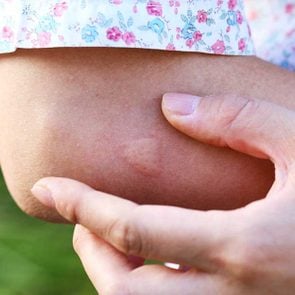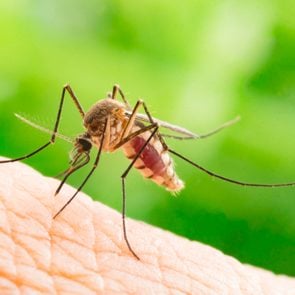Here’s How to Tell the Difference Between a Chigger Bite and a Bed Bug Bite
Updated: Dec. 04, 2020
Ugh—you're scratching and you'd really like to know what bit you: Chigger and bed bug bites often look similar, but there are key differences. Here's what you need to know—and how to protect yourself.
Chigger bites vs. bed bug bites
Chigger and bed bug bites may look similar to the naked eye. They both feed off humans and can leave a trail of bumps on your skin. This can cause itchiness and overall skin irritation. However, this is where the similarities end. Learn how to tell the difference when you get a chigger bite and a bed bug bite.
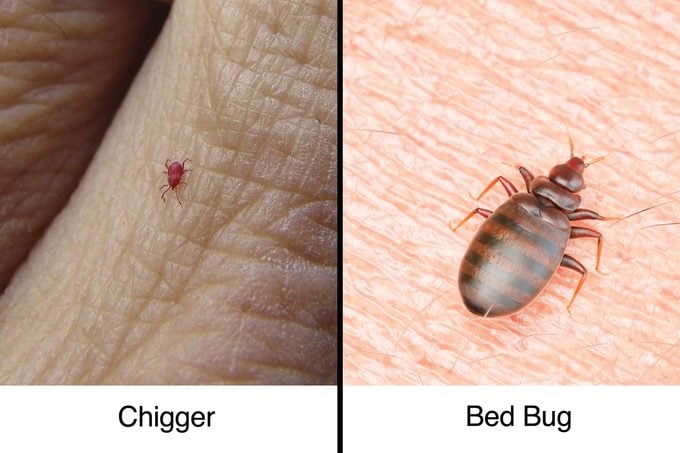
Where you’ll find chiggers
“Chiggers are an outdoor biting pest. They feed once, and will not reproduce indoors and have continuous generations,” says entomologist Jody Green, at the University of Nebraska. They are typically found in wild plantings, gardens, pollinator habitat, woods and brush, long grass fields, trail edges, dense shrubbery, or even on short, manicured lawns. Chiggers are tiny, only about 1/100 of a millimeter in size and only bite us when they’re in the larvae stage. (Learn more about what chigger bites look like.)
Where you’ll find bed bugs
Bed bugs, on the other hand, prefer the indoors, specifically living in objects. These oval-shaped reddish-brown insects live in mattresses, box springs, and baseboards—or anything that is within a short crawling distance to humans, who provide their blood meals. (Check out these expert tips on how to get rid of bed bugs.) “Bed bugs will infest your home, feed repeatedly, mate, reproduce, and continue to feed inside,” says Green. And by feeding, she means a meal of your blood. They go virtually unnoticed due to their furtive behavior. (Here are the 8 signs you’re about to have a bed bug problem.)
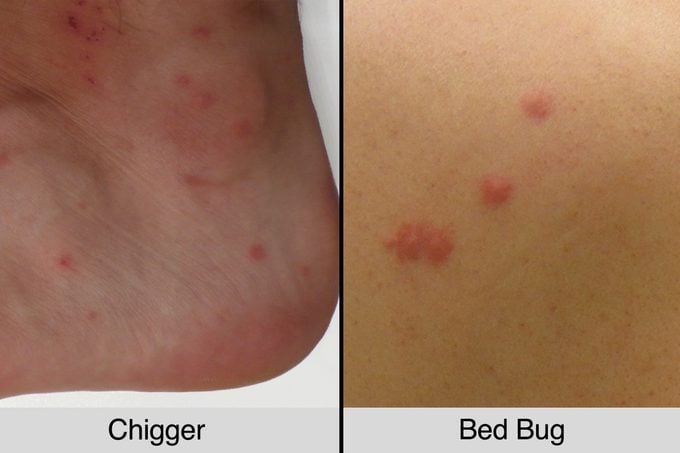
Chigger and bed bug bite symptoms
Chigger and bed bug bites are very itchy, but the bites rarely pose serious health issues—unless you scratch too much and the bite gets infected. The bugs leave different bite marks: “Location and number are typically what distinguishes them,” says dermatologist Adam Friedman, MD, professor and interim chair of dermatology at The George Washington University School of Medicine & Health Sciences. (If you’re not clear on the difference, here’s how to tell a chigger bite vs. a mosquito bite.)
Chigger bites
Chiggers will typically deliver a higher number of smaller sized bites, and they tend to target the lower legs, explains Dr. Friedman. Bites often appear as small, reddish, bumps that look like pimples, with severe itching that is often worse at night. Entomologist Jody Green was bitten by chiggers and she describes it as “the most annoying and most intensely insane itching I’ve experienced.”
Chigger bites turn up near the ankles and behind the knees, along with any spot where your clothing fits tighter (a waistband, bra line, or the top of socks). “They will migrate to areas of “protection,” and in this case, you can see multiple little “bites” in a line along the waist for example,” says, Dr. Friedman. And they’ve been known to bite in moist places like the groin and armpit area too. (Stock up on these chemical-free insect repellents to keep bugs at bay.)
Bed bug bites
“With bed bugs, you will likely get only a handful, often grouped in a line or geometric shape,” says Dr. Friedman. “This is called the ‘breakfast, lunch, and dinner sign’ indicting three meals that the bedbug drank from the host.” Bed bug bites are commonly found on where the skin was exposed while sleeping. They sometimes look like a rash or hives on the skin, depending on where the bed bug traveled and how many places it stopped for its blood meal.
Some people may get welts from the bite, or surprisingly have no symptoms at all. “The most challenging thing about bed bug bites is that there is a portion of the population that do not react to them and so they have no adverse skin responses and have no idea that they are being fed upon while they are sleeping,” says Green. Dr. Friedman notes that the individual reaction could have to do with the individual’s immune response to the salivary proteins secreted by the bed bug. So, even when two people sleep in the same bed and both get bitten, it’s possible for one or both not to have a reaction. (Whether you’re itching or not, these are clear signs that you have a bed bug problem.)
How long does it take to see a bug bite reaction?
Chigger reaction
Chigger bites can occur at any time, whether you’re outside during the day or at night. You may react to getting bit, and ask yourself, “What just bit me?” But you may not see the reddish bite marks that look like pimples or feel the miserable itching right away, says Dr. Friedman: Reactions tend to occur in about six to 12 hours but can take longer. (Keep an eye out for these dangerous bugs this summer.)
Bed bug reaction
As with chigger bite reactions, it usually takes six to 12 hours or more before you see a reaction. “We all have our own immune response, so it can vary among individuals,” says Green. And sometimes, the reaction itself changes from one incident to another. (Here are the best ways to treat every type of bug bite.)
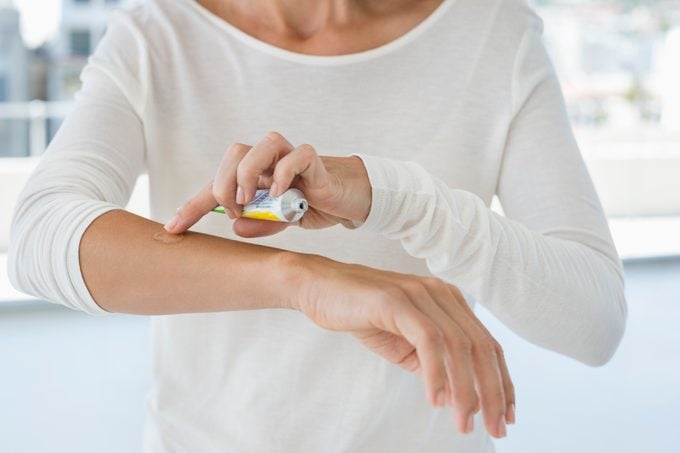
How to treat bug bites
Chigger treatment
You might not want to know the mechanics behind a chigger bite, but when you do, it helps to understand why you’re itching and why the itching lasts so long. “Chiggers pierce the skin with a small mouthpart and secrete enzymes into your skin, breaking it down. At the same time, they create a channel or tube (called a stylostome) to suck up the liquified skin cells,” says Green. The damage from the skin breaking and the longer the bugs feed will increase your itchiness. Until new skin starts to grow over the stylostomes, you’ll be miserable. For Green, it took about one week of “untrollable itching.” For others, it can take two weeks to a month. To get relief from itching, Dr. Friedman has a few suggestions. “Oral antihistamines or topical corticosteroid creams/ointment. Cold compresses (ice, frozen peas) may also help to obscure the sensation and limit swelling.” (Make your own DIY doctor-approved ice packs with things you already have in your house.)
Bed bug treatment
The treatment for chigger bites is identical to bed bug bites Dr. Friedman says. How many tubes of oral antihistamines you use may depend on your reaction to the bite. “The response will vary as it is an immune response to salivary proteins secreted by the bed bug,” says Dr. Friedman. Or you just may have more bites to treat because the bed bugs were “blood hopping” on your skin, searching for the ideal capillary space that makes it possible for the blood to flow into their bodies quickly. The bed bug may probe multiple times on your skin before it starts to feed. (Here are some other secrets bed bugs don’t want you to know.)
When to see a doctor for a bug bite
Chigger and bed bug bites can result in unbearable itching. If you can’t stop itching, call your doctor or dermatologist to get a prescription for a higher potency topical steroid. If you keep scratching, it can lead to a secondary skin infection. Dr. Friedman says whether you have chigger or bed bug bites, call your doctor if you have pain, swelling, pus (white or greenish discharge), fever, weakness, or joint pain. You might not even have to go to the doctor’s office for a diagnosis. (Find out how to make a telehealth appointment work for you.)
How to prevent bug bites
Chigger prevention
Even given their known habitat (outdoors, near trails, in the woods, fields with tall grass), chiggers can basically be anywhere Green says. That’s why you shouldn’t walk barefoot or sit directly on the grass. The best way to prevent chigger bites is covering up, which might not be too appealing in hot summer temperatures but is essential, especially if you know you’ll be in known chigger territory. “Wear long pants, long sleeves, shoes, boots to cover up and keep chiggers on the outside. Tuck your pants into your shoes or boots and tuck your shirt into your pants,” advises Green. She also recommends wearing permethrin-treated clothing and also DEET (25-30 percent) on the skin.
Because chiggers can hitchhike on clothing, prevent more bites by immediately taking a shower and scrubbing the skin once you get inside. Be sure to wash and dry soiled clothes on high heat to kill chiggers. Wipe down shoes and boots. You can also cut mitigate the chances of getting chigger bites by keeping turf short and vegetation trimmed. Green says residual insecticides (synthetic pyrethroids) with the active ingredient, bifenthrin, can help suppress chiggers, but spraying large areas can kill beneficial insects and pollinators. (Don’t overlook these surprising hazard zones in your backyard.)
Bed bug prevention
Bed bugs are hardy and resistant to insecticides. “There’s nothing a human can spray on themselves to ward off bedbugs,” says Green. Avoiding bites means not letting bed bugs into your home. Bed bugs enter homes riding in backpacks, luggage, clothing, used furniture, or anything else they can hide in. (Some bed bugs might hitch a ride in your car.) “Bed bug bite prevention is more related to checking your bedding and surrounding areas, using a bedbug-proof mattress cover, reducing clutter to eliminate hiding spots, and checking luggage before bringing it inside the home,” says Green. Eliminating a bed bug infestation isn’t something you should attempt on your own. Seek a professional exterminator that offers an integrated approach involving both non-chemical and chemical methods to minimize any hazards to people, pets, property, and the environment.























